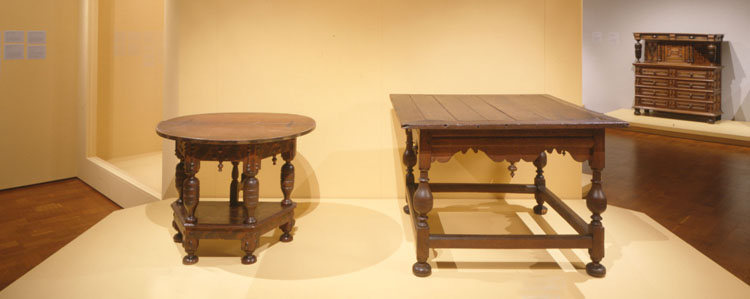Square Joined Table, 1685—90
Ipswich or Newbury, Massachusetts
Oak
Lent by Wadsworth Atheneum, Wallace Nutting Collection, Gift of J. Pierpont
Morgan
This square table is attributed to the shop that made the cupboards. It has
posts with the feet, blocks, and pillars all made of one solid piece of oak,
a virtuoso technical feat that required careful wood selection and masterful
turning. These legs are the only large-scale pillar turnings executed in oak
by this shop tradition. The multiple-board oak top is detachable for ease
of transport. It is made of multiple riven oak boards held together by mitered
pieces of wood called cleats on two sides. The surfaces of these boards have
been planed down as much as half an inch, probably to flatten the top after
it had warped. So much wood was removed that the pegs securing the cleats
are exposed in places.

Round
Leaf Table, 1680—85
Ipswich or Newbury, Massachusetts
White oak and maple
Lent by The Metropolitan Museum of Art, Gift of Mrs. J. Insley Blair
This rare and magnificent table and the one next to it are both attributed to
the shop that generated the cupboards. The two tables are constructed in different
ways. This round leaf table piles up alternating maple and oak layers, with
maple feet and pillars attached to oak frames at the shelf and frieze level.
No other surviving leaf table of this kind in England or America was made this
way. The present painted decoration dates from the 1700s and is not the original
treatment. One of the turned pendants is original; it is the only surviving
example of this feature for the entire shop tradition. The top boards and the
lower shelf board are made of wide, water-sawn oak.

